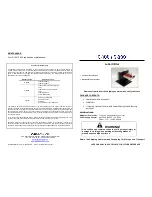
clean and dry, and the lid is closed.
INTRODUCTION OF BREAD INGREDIENTS
1. Bread flour
Bread flour has high content of high gluten (so it can be also called high-gluten flour
which contains high protein), it has good elastic and can keep the size of the bread from
collapsing after rise. As the gluten content is higher than the common flour, so it can be
used for making bread with large size and better inner fiber. Bread flour is the most
important ingredient of making bread.
2. Plain flour
Flour that contains no baking powder, it is applicable for making express bread.
3. Whole-wheat flour
Whole-wheat flour is ground from grain. It contains wheat skin and gluten. Whole-wheat
flour is heavier and more nutrient than common flour. The bread made by whole-wheat
flour is usually small in size. So many recipes usually combine the whole -wheat flour or
bread flour to achieve the best result.
4. Black wheat flour
Black wheat flour, also named as“rough flour”, it is a kind of high fiber flour, and it is
similar with whole-wheat flour. To obtain the large size after rising, it must be used in
combination with high proportion of bread flour.
5. Self-rising flour
A type of flour that contains baking powder, it is used for making cakes specially.
6. Corn flour and oatmeal flour
Corn flour and oatmeal flour are ground from corn and oatmeal separately. They are the
additive ingredients of making rough bread, which are used for enhancing the flavor and
texture.
7. Sugar
Sugar is very important ingredient to increase sweet taste and color of bread. And it is also
considered as nourishment in the yeast bread. White sugar is largely used. Brown sugar,
powder sugar or cotton sugar may be called by special requirement.
8. Yeast
After yeasting process, the yeast will produce carbon dioxide. The carbon dioxide will
expand bread and make the inner fiber soften. However, yeast fast breeding needs
carbohydrate in sugar and flour as nourishment.
1 tsp. active dry yeast =3/4 tsp. instant yeast
1.5 tsp. active dry yeast =1 tsp. instant yeast
2 tsp. active dry yeast =1.5 tsp. instant yeast
Yeast must be stored in the refrigerator, as the fungus in it will be killed at high
temperature, before using, check the production date and storage life of your yeast. Store it
back to the refrigerator as soon as possible after each use. Usually the failure of bread
rising is caused by the bad yeast.
The ways described below will check whether your yeast is fresh and active.
(1) Pour 1/2 cup warm water (45-500C) into a measuring cup.
(2) Put 1 tsp. white sugar into the cup and stir, then sprinkle 2 tsp. yeast over the water.
(3) Place the measuring cup in a warm place for about 10min. Do not stir the water.
(4) The froth should be up to 1 cup. Otherwise the yeast is dead or inactive.
9. Salt
Salt is necessary to improve bread flavor and crust color. But salt can also restrain yeast
from rising. Never use too much salt in a recipe. But bread would be larger if without salt.
10. Egg
Eggs can improve bread texture, make the bread more nourish and large in size, the egg
must be peeled and stirred evenly.
11. Grease, butter and vegetable oil
Grease can make bread soften and delay storage life. Butter should be melted or chopped
to small particles before using.
12. Baking powder
Baking powder is used for rising the Ultra Fast bread and cake. As it does not need rise
time, and it can produce the air, the air will form bubble to soften the texture of bread
utilizing chemical principle.
13. Soda
It is similar with baking powder. It can also used in combination with baking powder.
14. Water and other liquid
Water is essential ingredient for making bread. Generally speaking, water temperature
between 200C and 250C is the best. The water may be replaced with fresh milk or water
mixed with 2% milk powder, which may enhance bread flavor and improve crust color.
Some recipes may call for juice for the purpose of enhancing bread flavor, e.g. apple juice,
orange juice, lemon juice and so on.
INGREDIENTS MEASUREMENT
One of important step for making good bread is proper amount of ingredients. It is
strongly suggested that use measuring cup or measuring spoon to obtain accurate amount,
otherwise the bread will be largely influenced.
1. Weighing liquid ingredients
Water, fresh milk or milk powder solution should be measured with measuring cups.
Observe the level of the measuring cup with your eyes horizontally. When you measure
cooking oil or other ingredients, clean the measuring cup thoroughly without any other
ingredients.
2. Dry measurements
Dry measuring must be done by gently spooning ingredients into the measuring cup and
then once filled, leveling off with a knife. Scooping or tapping a measuring cup with more
than is required. This extra amount could affect the balance of the recipe. When measuring
small amounts of dry ingredients, the measuring spoon must be used. Measurements must
be level, not heaped as this small difference could throw out the critical balance of the
recipe.
3. Adding sequence
The sequence of adding ingredients should be abided, generally speaking, the sequence is:
liquid ingredient, eggs, salt and milk powder etc. When adding the ingredient, the flour
can't be wetted by liquid completely. The yeast can only be placed on the dry flour. And







































